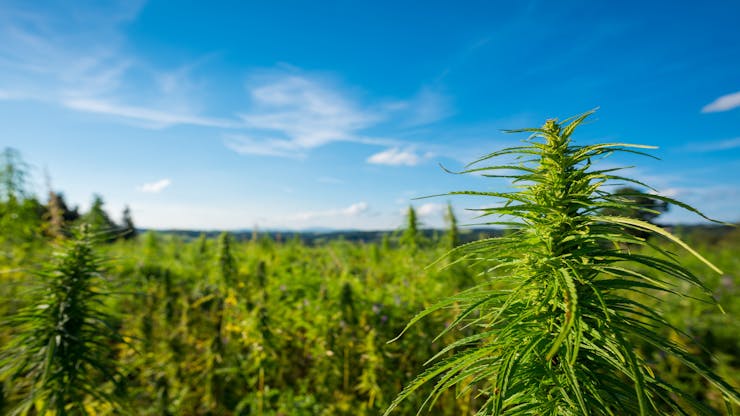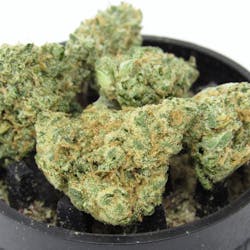For centuries, what we call cannabis today was known as hemp in the English-speaking world. The hemp of olden days was used by our ancestors as a source of food (its seeds), and the fibers of its stalks were used for creating materials, mainly rope and clothing. More familiarly, hemp flower was also smoked and consumed as a medicine and in spiritual ceremonies, but it was much less potent than today’s weed, with THC levels we modern humans would laugh at.
Ancient texts largely refer to this incredibly useful plant as hemp, and the distinction between hemp and cannabis didn’t come about until the 20th century. Today, we divide this one plant into two categories according to its use: When it’s consumed for medicinal, spiritual, or recreational purposes it’s known as cannabis; when it’s used for food (seeds, oil, milk, etc.) or materials (clothing, rope, etc.), it’s called hemp.
But they are the same plant.
Hemp has evolved into a legal term, defined in the US simply as cannabis plants with less than 0.3% THC. This negligible amount of THC means you can’t get high from smoking it, but people can grow it for food and materials.
In the United States, the federal prohibition against growing hemp ended when Congress passed the Agriculture Improvement Act of 2018 (also known as the 2018 Farm Bill). However, in the past few years the line between hemp and cannabis has blurred. Hemp plants are now used as source material to extract CBD and novel cannabinoids such as delta-8 and THC-O.
Consuming these products can get you high like good ol’ weed (albeit, less high, in many cases), but as the products are extracted from plants with less than 0.3% THC—that is, hemp—the products can avoid the federal prohibition against cannabis. They are considered legal at the federal level.
What’s the difference between hemp and cannabis?
Hemp and cannabis are the same plant. The difference lies in what they’re composed of, how they look, and how they’re used.
Defining hemp
Hemp and cannabis are the same plant, but today when we speak of hemp, we’re referring to a cannabis plant containing less than 0.3% THC by weight. This is purely a legal term. The 0.3% limit is somewhat arbitrary—if the US government were to raise the hemp THC limit to 1%, overnight, plants containing 0.4 – 1% THC would suddenly go from being called cannabis to hemp, and would be considered federally legal.
The negligible amount of THC in hemp means you can’t get high from it. Hemp was legalized to allow it to be grown for its seeds, which can be used as food, and for its fiber, which can be used for making materials. Because of these uses, it may also be referred to as industrial hemp.
The 2018 farm bill legalized hemp in the US, setting its THC limit at 0.3%.
What does hemp look like?


Hemp often looks like a much skinnier, splindly form of weed. It’s usually thin, tall, and lanky, and has thin, skinny leaves that are usually green and sometimes yellowish. If you know your weed plants, hemp is the opposite of short, squat indicas with fat leaves and purple hues.
Shop highly rated dispensaries near you
Showing you dispensaries nearDoes hemp grow buds?
Yes, female hemp plants grow buds, just like cannabis, as they are the same plant. Hemp buds are primarily used to extract CBD, which can then be refined into delta-8 THC, THC-O, and other novel cannabinoids. The seeds of female hemp plants can be harvested and consumed as food. The stalks of both male and female plants can be harvested for their fiber and used in a variety of materials.
What is hemp used for?
Hemp—or cannabis, as our ancestors didn’t distinguish between the two—is one of the oldest plants cultivated by humans, thought to have been grown as far back as 5,000-6,000 years ago.
This one plant was, and still is, highly beneficial because:
- Its seeds can be consumed as food
- Its fiber can be used for materials
- Its flower can be consumed for medical or intoxicating purposes
And we still use it for these purposes today.
Extracting CBD and novel cannabinoids
Since hemp became legal in the US after the 2018 farm bill, there has been an explosion of products containing CBD and novel cannabinoids such as delta-8, delta-10, THC-O, HHC, and many more. A huge amount of the nation’s hemp harvest has gone into creating these products in the past few years, as they can allow people living in states where weed is prohibited to get high with less legal risk.
These compounds can get you high—not high like regular delta-9 THC, but to some degree. For example, delta-8 and delta-10 offer similar effects as delta-9 THC, but are much less potent, while THC-O is thought to be three times as strong as delta-9 THC.
Hemp and cannabis contain all of the above compounds in addition to THC (plus hundred more), albeit in small amounts.
Producers will often extract CBD as a crude oil from hemp plants, and either refine it for a marketable CBD oil, or chemically convert it into another compound, such as delta-8 or THC-O.
It’s important to note that these hemp-derived novel cannabinoids exploit a federal loophole, but they are not subject to state-mandated testing or regulation. We recommend consumers who buy these products look for trusted brands whose manufacturers test their products and have results available for consumer scrutiny.
Hemp fibers for materials
When used for non-consumable materials and products, the plant is often referred to as industrial hemp. Here are some materials that hemp can be turned into:
- Clothing and other textiles
- Rope
- Paper
- Building materials (like hempcrete, and insulation)
- Bioplastics
- Biofuel
- Mulch and compost
- Livestock feed and bedding
The fiber of the hemp plant’s stalk is used to make these materials. When it’s grown for industrial purposes, hemp is cultivated using methods to maximize the plant’s stalk material. Stalks contain an outer layer of long string-like bast fibers (considered more versatile and valuable) and an inner layer of chip-like hurd, which is considered less valuable.
Fun fact: During WWII, Japan invaded the East Indies, slowing the trade of hemp fiber. As a consequence, the US government lifted the ban on hemp and encouraged American farmers to grow it for use in making rope, parachutes, and other materials vital to the war effort. The US government even produced a short propaganda film in 1942 called “Hemp for Victory,” encouraging farmers to grow hemp.
Eating hemp
You can eat hemp too. Hemp seeds are a great source of protein, something our ancestors knew, and another reason why the plant was so valuable to early humans. People often sprinkle hemp seeds on top of food, like salads or granola, or add them to muffins and other baked goods.
Hemp seeds can also be blended with water to make hemp milk, and used as a substitute for dairy milk or other plant-based milks.
Hemp oil can be extracted from seeds and used as a cooking oil, like olive oil, avocado oil, or vegetable oil.
Can you get high from hemp?
Smoking hemp flower itself won’t get you high because, by legal definition, it contains only 0.3% THC, which is not enough for you to feel effects like you would when smoking cannabis. Only when a naturally occuring hemp compound like CBD is extracted, or chemically converted to another compound—such as delta-8 THC or THC-O—and consumed, will you feel high.
The hemp of our ancestors was dramatically less potent than the cannabis of today, but it was likely higher in potency than 0.3% THC. So yes, our ancestors could get high from hemp back then, and they did use it for spiritual and medicinal purposes.
Is hemp legal?
Hemp was made legal in the United States with the passage of the Agriculture Improvement Act of 2018, aka, the farm bill, in December of that year. The farm bill removed hemp from the Controlled Substances Act of 1970, separating it from marijuana, and defining hemp as a cannabis plant containing less than 0.3% THC by dry weight. Hemp was separated from cannabis so it could be grown and used for industrial purposes, or materials and food.
To grow hemp, one needs a license from a state, tribal program, or the USDA. Hemp is legal to grow in 46 states except for Idaho, Mississippi, South Dakota, and New Hampshire.
Transporting hemp across state lines is legal in theory, but there have been many cases in the past few years of police arresting people for shipping hemp, thinking it was cannabis. In some instances, companies have lost huge shipments without compensation.
Are hemp-derived cannabinoids legal?
Despite the federal government legalizing hemp, some individual states have caught on to the fact that companies are using hemp to create products with intoxicating cannabinoids, and have outlawed these compounds on their own, such as delta-8 THC.
Confusingly, this can be true even in states that have legal cannabis. Oregon, for example, will outlaw all “artificially derived cannabinoids”—a catch-all term for all hemp-derived cannabinoids except CBD—on July 1, 2022. Be sure to check your state’s laws to see if a specific product is legal there.
The definition of hemp may change in the future
The limit of 0.3% THC in a hemp plant is a legally and scientifically arbitrary number. This specific limit is thought to have been first proposed in the 1976 study A Practical and Natural Taxonomy for Cannabis, setting a precedent.
However, in many places, the definition of hemp is based on a different number. In Switzerland, the Czech Republic, and some (but not all) Australian states, hemp plants are defined as cannabis containing less than 1% THC. In Italy, it’s 0.6%.
In Nov. 2021, the European Parliament raised the legal limit of THC in hemp from 0.2% to 0.3%—a seemingly small number, but the slight increase gave farmers access to hundreds of hemp varieties previously unavailable.
All of these examples show that hemp is purely a legal definition, and it can change based on what country you’re in, and if your government feels inclined to do so.
Many bills have been written in the US to raise the hemp limit to 1% THC, most recently in Feb. 2022. The specific level of THC in a plant can be difficult to control when growing, so the main drive for these bills is to give hemp farmers more flexibility, as they wouldn’t have to destroy their crops if they come in “hot”—that is, above 0.3% THC.
A level of 1% THC is still a negligible amount and not enough to get you high, and the increase would give hemp farmers more leeway in producing their crops.





